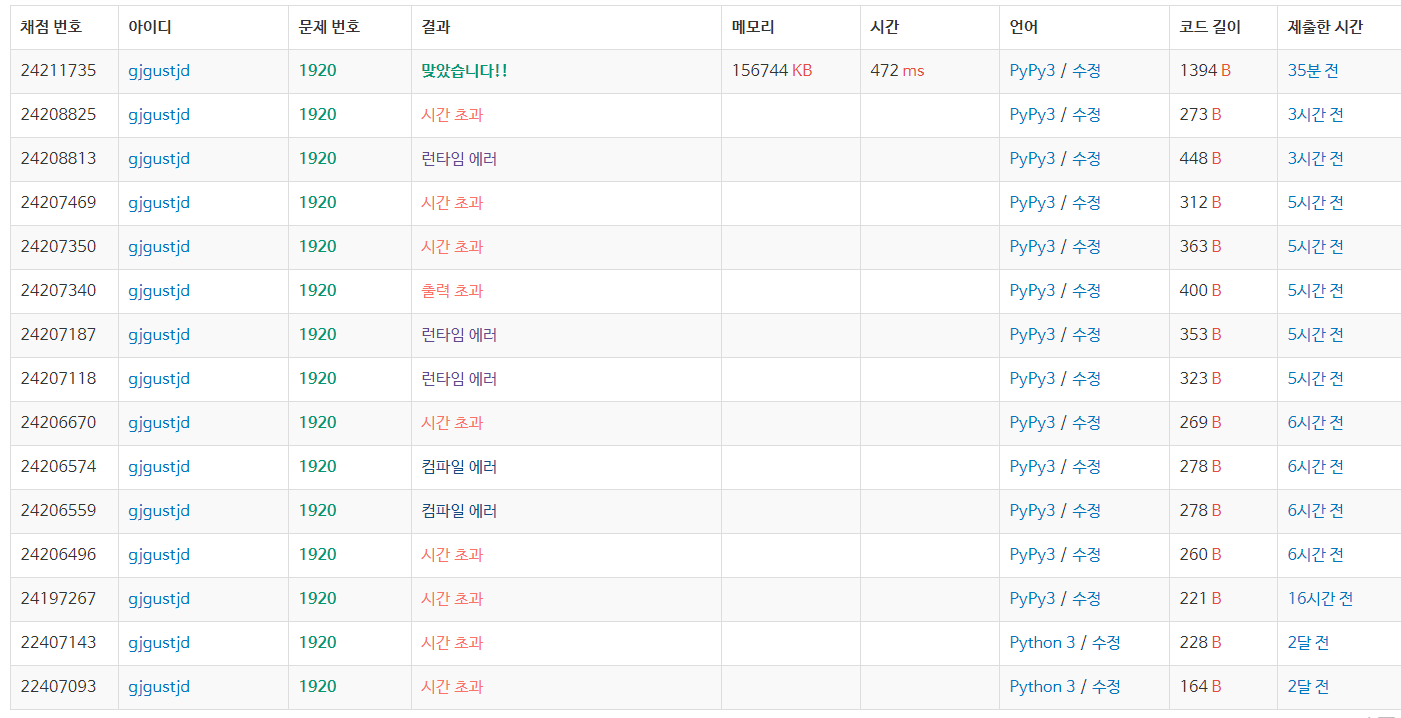-
[PS] 수 찾기Problem Solving 2020. 12. 5. 01:03

수열을 입력받고, 찾아야 하는 수들이 포함된 배열을 추가로 입력받아
수열 내에 수들이 포함되어 있는 지에 대한 여부를 1 또는 0으로 출력해야 하는 문제이다.
n = int(input()) entries = input().split() m = int(input()) tofind = input().split() result =[0]*m for i in entries: for b in range(0,m): if int(i) == int(tofind[b]): result[b] = 1 for u in result: print(u)<1차 시도>
우선 입력받은 수열을 반복문으로 전체 순회하고,
하나의 요소를 찾아야할 수열 중에 하나와 일치하는 지를 반복문으로 순회하여 판별하는 방식으로 진행.
결과는 당연히 시간 초과!
import sys input = sys.stdin.readline n = int(input()) entries = input().split() m = int(input()) tofind = input().split() result =[0]*m for i in entries: for b in range(0,m): if int(i) == int(tofind[b]): result[b] = 1 break for u in result: print(u)<2차 시도>
1차 시도 코드에서 비효율적인 부분이 어느 곳이 있을까 생각해보았는데,
입력된 수열의 수 하나와 찾아야할 수열 중의 하나를 비교하는 과정에서,
중간에 해당 수를 찾아도, 순회를 계속하고 있었기 때문에, break를 통해 이후의 순회는 버렸다.
결과는 이번에도 시간 초과.
import sys input = sys.stdin.readline n = int(input()) entries = input().split() m = int(input()) tofind = input().split() result =[0]*m for i in entries: if len(tofind) < 1: break for b in range(0,len(tofind)): if int(i) == int(tofind[b]): result[b+(len(result)-len(tofind))] = 1 tofind.remove(tofind[b]) break for u in result: print(u)<3차 시도>
더 나아가서, 찾아야 할 수를 찾았다고 판단되면,그 배열에서 해당 수를 빼서 순회할 개수를 줄이는 방식으로 진행하였다.
하지만 그와 함께 해당 배열의 인덱스가 변경된다.
결과를 담을 배열이 원본 배열의 크기와 같으므로,해당 크기에서 현 배열의 크기를 빼면,
몇 개를 빼었는지 나오므로,인덱스에 그만큼 더해주면 원래 인덱스가 나오게 된다.
이런 방식으로 비교를 계속하다, 찾아야 할 수들의 배열 갯수가 0이 되면 배열 순회를 그만두고 결과를 출력한다.
import sys input = sys.stdin.readline n = int(input()) entries = input().split() m = int(input()) tofind = input().split() result =[0]*m for i in entries: if len(tofind) < 1: break if i in tofind: result[tofind.index(i)+(len(result)-len(tofind))] = 1 tofind.remove(i) for u in result: print(u)<4차 시도>
더 간결하게 만들어볼 수 없을까 생각하다가 나온 방안이 파이썬의 문법을 이용하는 것.
코드는 상당히 간결해졌으나, 실행 시간을 측정해보니 실제로는 전의 내가 짠 코드가 훨씬 빨랐다.
import sys import time import math def mergesort(entries): if isinstance(entries,list) and len(entries) > 1 : pivot = math.floor(len(entries)/2)-1 first = mergesort(entries[:pivot+1]) second = mergesort(entries[pivot+1:]) return merge(first,second) else: return entries def merge(first,second): unit=[] if not isinstance(first,list): first = [first] if not isinstance(second,list): second = [second] first_p = second_p = 0 while first_p <len(first) and second_p <len(second): if first[first_p]<second[second_p]: unit.extend([first[first_p]]) first_p+=1 else: unit.extend([second[second_p]]) second_p+=1 if first_p>=len(first) and second_p<len(second): unit.extend(second[second_p:]) else: unit.extend(first[first_p:]) return unit def binarysearch(entries,target): left = 1 right = len(entries) mid = 0 while left<=right: mid = math.floor((left+right)/2) if entries[mid-1] == target: break elif entries[mid-1] < target: left = mid+1 else: right = mid -1 if entries[mid-1] == target: return 1 else: return 0 n = int(input()) entries = input().split() entries = list(map(int,entries)) m = int(input()) tofind = input().split() tofind = list(map(int,tofind)) entries = mergesort(entries) entries = list(map(int,entries)) for x in tofind: print(binarysearch(entries,x))<최종 시도>
앞의 코드들로는 더 효율적으로 만들 수 없을 것 같아 리서치를 진행했더니,
이진 탐색이 훨씬 빠르다는 말이 있었다.
나는 그것을 듣고 조금 의아했다.왜냐하면 이진 탐색은 정렬된 배열을 전제로 하는 탐색이기 때문이다.
정렬을 하면 그만큼의 시간이 더 들어가는 것이 아닌가?하고 생각했지만,
다른 사람들은 다 그렇게 하고 있는 것 같았다.
정렬 알고리즘은 병합 정렬을 사용하였고, 이진 탐색을 진행하여 찾은 결과가 맞으면 1,0을 반환하도록 응용하였다.

결과는 성공.
전에 해왔던 것들보다 훨씬!훨씬 빨랐다.
이진탐색이 꽤나 쓸만하다는 것을 직접 피부로 경험한 순간이었다.
'Problem Solving' 카테고리의 다른 글
[PS]좌표 정렬하기 (0) 2020.12.10 [PS]수 정렬하기 3 (0) 2020.12.03 [PS] 단어 정렬하기 (0) 2020.12.02 [PS] 백준 - 수 정렬하기 2 (0) 2020.11.19